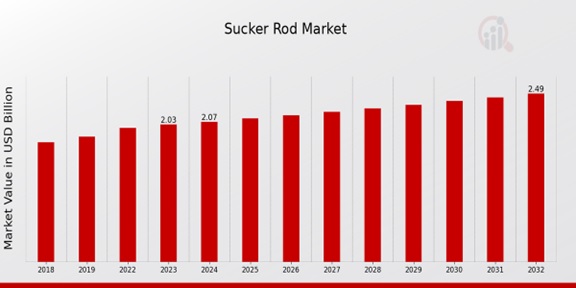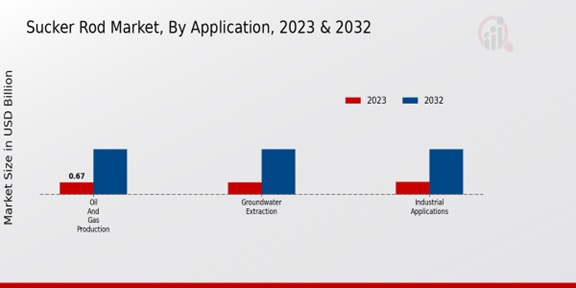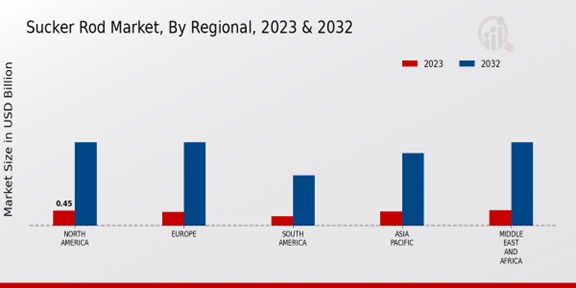Global Sucker Rod Market Overview
As per MRFR analysis, the Sucker Rod Market Size was estimated at 1.98 (USD Billion) in 2022. The Sucker Rod Market Industry is expected to grow from 2.03(USD Billion) in 2023 to 2.49 (USD Billion) by 2032. The Sucker Rod Market CAGR (growth rate) is expected to be around 2.31% during the forecast period (2024 - 2032).
Key Sucker Rod Market Trends Highlighted
The sucker rod market is witnessing significant growth due to the increasing demand for oil and gas exploration and production. The rise in unconventional oil and gas resources, such as shale and tight formations, has led to an increased requirement for sucker rods for artificial lift operations. Moreover, the growing adoption of horizontal drilling and extended-reach wells has created a favorable landscape for the sucker rod market. Key market drivers include the rising production of unconventional oil and gas, advancement in sucker rod technologies, and increased investments in exploration and production activities. Additionally, the need for reliable and efficient artificial lift solutions in remote and challenging operating environments is driving the demand for sucker rods. Recent trends in the sucker rod market include the development of lightweight and durable materials, such as carbon fiber and composite materials, which offer higher strength and reduced weight. Advances in rod design, including tapered or profiled rods, have enhanced performance and extended the life of sucker rods. The adoption of automation and digital technologies in sucker rod operations is expected to further optimize efficiency and reduce downtime.

Source: Primary Research, Secondary Research, MRFR Database and Analyst Review
Sucker Rod Market Drivers
Increasing Demand for Oil and Gas Production
The major driving force of the Sucker Rod Market Industry is the growth of oil and gas production. Sucker rods are components of artificial lift systems which are used to extract hydrocarbons from the well. The artificial lift systems are used to lift the gas and liquid products to the surface. As the global requirement for energy is increasing, the measures of efficient methods of oil and gas production are crucial. The sucker rod system lifts the fluid from wells effectively and at a limited cost, which is important for the global oil gas industry. Growing exploration and production in developing economies are another reason owing which the demand for the sucker rod is growing. Apart from this, the recovery of the oil from the existing well is important.
Technological Advancements and Innovations
It is safe to conclude that the leading power behind the expansion of the Sucker Rod Market Industry pertains to technological emergence and innovations. Producers involve cutting-edge technology for research and developmental activities in a bid to present products with additional strength and durability devoid of an increase in total cost or presence of overweight. Over the years, the usage of new materials in the abstract applications of sucker rods includes high-strength alloys in combination with composites. Ones created through technology are unlike those used previously and are now lighter and more durable. Further, changes in modern manufacturing processes are also utilized because manufacturing units depend on automated procedures such as welding.
They are indispensable in the creation of articulated sucker rods and uncomplicated sucker rods. These new levels of technological applications have facilitated the presence of rod dimensions with increased functions, thereby making it possible to reduce the overall cost span and repair frequency in error instances. Automated manufacturing is associated with process logging and stimulus process integration, including the use of sensors for inspection, monitoring, and recognition of various kinds of juices involved in processing. These activities have greatly reduced global maintenance costs.
Growing Focus on Energy Efficiency and Sustainability
Energy efficiency and the push for sustainability are the second significant drivers of the Sucker Rod Market Industry. Production of oil and gas is inefficient without sucker rod systems. Enhancements in sucker rod technology also permit the industry to minimize energy consumption and environmental impact. For example, variable speed drivers, monitoring and real-time alert systems, and the concept of condition-based or predictive maintenance enable the unique optimization of a system’s performance. This can reduce energy consumption and extend the lifespan of equipment.
Sucker Rod Market Segment Insights
Sucker Rod Market Application Insights
The Sucker Rod Market is segmented on the basis of Application into Oil and Gas Production, Groundwater Extraction, and Industrial Applications. Among these segments, Oil and Gas Production is expected to account for the largest revenue share in the Sucker Rod Market by 2024. The growth of the segment can be attributed to the increasing demand for oil and gas across the globe. In addition to this, the rising number of activities related to drilling and production of oil and gas is driving the growth of the oil and gas production application segment of the Sucker Rod Market. Groundwater Extraction is another application segment of the Sucker Rod Market.
The segment is expected to grow during the forecast period because of the increase in the demand for water for various purposes. Sucker rods are used for the extraction of groundwater from wells, and the rising demand for water is positively affecting the growth of the application segment of the Sucker Rod Market. The Industrial Applications segment is another application segment of the Sucker Rod Market. Sucker rods are used for a number of industrial purposes, like pumping slurry, chemicals, and other fluids. The growth of the segment can be attributed to the increasing demand for sucker rods for industrial applications. In conclusion, the Sucker Rod Market is growing and is expected to grow further during the forecast period. The growth of the oil and gas production, groundwater extraction, and industrial application segments is anticipated to drive the growth of the market. The market is also projected to benefit from the increasing adoption of automated sucker rod pumping systems.

Source: Primary Research, Secondary Research, MRFR Database and Analyst Review
Sucker Rod Market Material Insights
The Sucker Rod Market is segmented based on material into Carbon Steel, Stainless Steel, Fiberglass, and Aluminum. Among these, Carbon Steel is the most widely used material, accounting for over 60% of the global market share in 2023. This is primarily due to its high strength, durability, and relatively low cost. Stainless Steel is also a popular choice, especially in corrosive environments, and is expected to witness significant growth in the coming years. Fiberglass and Aluminum, on the other hand, are lightweight and corrosion-resistant materials, but they have lower strength compared to Carbon Steel and Stainless Steel. Despite this, they are gaining traction in certain applications, such as in deep wells and sour gas environments, where their lightweight properties offer advantages.
Sucker Rod Market Length Insights
The Sucker Rod Market segmentation by length (Up to 15 ft, 15 to 30 ft, Over 30 ft) provides valuable insights into the market's dynamics and growth potential. The 'Up to 15 ft' segment is estimated to hold a significant market share, driven by its widespread use in shallow wells and its cost-effectiveness. The '15 to 30 ft' segment is projected to witness steady growth due to its applicability in medium-depth wells. The 'Over 30 ft' segment is anticipated to gain traction, owing to its growing adoption in deep wells and its ability to withstand higher loads.
Sucker Rod Market End Connection Insights
The Sucker Rod Market Industry can be segmented based on End Connection into Pin-to-Pin, Box-to-Box, and Pin-to-Box. Among these segments, the Pin-to-Pin segment held the largest market share in 2023, accounting for over 60% of the Sucker Rod Market revenue. The Box-to-Box segment is expected to grow at the highest CAGR during the forecast period, driven by the increasing demand for higher strength and durability in sucker rods. The Pin-to-Box segment is also expected to witness significant growth, owing to its cost-effectiveness and ease of installation. These segments provide valuable insights into the Sucker Rod Market segmentation and dynamics, enabling stakeholders to make informed decisions and capitalize on growth opportunities.
Sucker Rod Market Regional Insights
The regional segmentation of the Sucker Rod Market offers valuable insights into the market's performance across different geographical regions. North America leads the market with a significant share, driven by the presence of major oil and gas-producing countries such as the United States and Canada. Europe holds a substantial market share due to its mature oil and gas industry and increasing exploration and production activities. The APAC region is projected to witness significant growth in the coming years, owing to rising energy demand and growing investments in the oil and gas sector, particularly in countries like China and India. South America and MEA also contribute to the global market, with Brazil and Saudi Arabia being key players in these regions.

Source: Primary Research, Secondary Research, MRFR Database and Analyst Review
Sucker Rod Market Key Players And Competitive Insights
Major participants in the Sucker Rod Market industry are increasingly focused on developing and introducing new and advanced products in order to meet the changing needs of customers. This is expected to further increase competition in the Sucker Rod Market market during the forecast period. Leading players of the Sucker Rod Market are employing a number of strategies to gain a competitive advantage in the market. These strategies include, among others, mergers and acquisitions, joint ventures, partnerships and collaborations. Mergers and acquisitions help companies expand their product portfolio and market share and acquire new technologies and markets.
At the same time, joint ventures, partnerships and collaborations help companies to share resources, expertise and costs and, at the same time, to expand their reach. One of the most important competitors in the Sucker Rod Market market is NOV. The company offers a wide array of sucker rods, including API sucker rods, premium sucker rods and fiberglass sucker rods. It also offers a number of services, such as sucker rod design, engineering and field support. The company has a wide international presence, and it serves clients in more than 100 countries. Another major competitor of the Sucker Rod Market is Weatherford International. Weatherford International has a wide array of sucker rods, including API sucker rods, premium sucker rods and fiberglass sucker rods. It also provides a number of services, such as sucker rod design, engineering and field support. It has a wide international presence, and it serves clients in more than 100 countries.
Key Companies in the Sucker Rod Market Include
- Dongkuk Steel
- Tenaris
- Hyundai Steel
- Shaanxi Jingui
- Sumitomo Metals
- Nippon Steel
- JFE Steel
- Shougang Group
- Kobe Steel
- Vallourec
- Hubei Sanzheng
- Weatherford
- NOV
- Baosteel
Sucker Rod Market Industry Developments
The sucker rod market is expected to reach USD 2.49 billion by 2032, exhibiting a CAGR of 2.31% during the forecast period (2024-2032). The market growth is primarily driven by the increasing demand for sucker rods in the oil and gas industry. Sucker rods are used to lift fluids from oil and gas wells, and the rising demand for energy is expected to boost the demand for sucker rods. Additionally, the growing adoption of artificial lift technologies, such as sucker rod pumps, is also contributing to the market growth. Recent developments in the sucker rod market include the introduction of new materials and technologies. For instance, in 2023, NOV introduced a new sucker rod material called NOValloy, which is claimed to provide superior strength and durability. Such advancements are expected to enhance the performance and efficiency of sucker rods, further driving the market growth.
In July 2024, NOV Inc. announced a collaboration to produce advanced sucker rods implementing monitoring systems to boost their efficiency in extreme conditions. The initiative complements the artificial lift diversity focus of NOV.
In May 2024, ChampionX expanded its product range by launching a corrosion-resisting sucker rod specifically focusing on offshore markets applications. The rods are expected to enhance durability and efficiency in operations.
In March 2024, Weatherford announced fiberglass sucker rods to assist in well productivity enhancement and energy consumption reduction in offshore operations.
In April 2024, TRC Services Inc. launched a remanufacturing program for steel sucker rods articulating sustainability and cost efficiency. This program is part of the broader objectives of TRC in establishing ESG.
In February 2024, Tenaris announced the invention of hollow sucker rods that enhance fluid management targeting unconventional resource plays, with the intention of ultimately lowering the total cost of ownership for operators.
In January 2024, Lufkin disclosed that it had bought a rod-making company in a bid to increase its share in the North American market to enhance its strategy of growth in artificial lift technologies.
In December 2023, Schlumberger introduced a virtual surveillance solution that comes alongside their sucker rod systems allowing proactive assessment, which enhances the safety aspect while reducing the wait time or the downtime as well.
In November 2023, Baker Hughes showcased a high-strength composite sucker rod for ultra-deepwater market application. This new technology can solve the problems such as high-pressure and high-temperature areas.
In February 2024, Baker Hughes collaborated with NOV to work on new materials for suck rods, such as NOValloy, which strengthen the resilience of oil wells and lowers the cost of maintaining them.
Sucker Rod Market Segmentation Insights
-
Sucker Rod Market Application Outlook
- Oil and Gas Production
- Groundwater Extraction
- Industrial Applications
-
Sucker Rod Market Material Outlook
- Carbon Steel
- Stainless Steel
- Fiberglass
- Aluminum
-
Sucker Rod Market Length Outlook
- Up to 15 ft
- 15 to 30 ft
- Over 30 ft
-
Sucker Rod Market End Connection Outlook
- Pin-to-Pin
- Box-to-Box
- Pin-to-Box
-
Sucker Rod Market Regional Outlook
- North America
- Europe
- South America
- Asia Pacific
- Middle East and Africa
| Report Attribute/Metric |
Details |
| Market Size 2022 |
1.98 (USD Billion) |
| Market Size 2023 |
2.03 (USD Billion) |
| Market Size 2032 |
2.49 (USD Billion) |
| Compound Annual Growth Rate (CAGR) |
2.31% (2024 - 2032) |
| Report Coverage |
Revenue Forecast, Competitive Landscape, Growth Factors, and Trends |
| Base Year |
2023 |
| Market Forecast Period |
2024 - 2032 |
| Historical Data |
2019 - 2023 |
| Market Forecast Units |
USD Billion |
| Key Companies Profiled |
Dongkuk Steel, Tenaris, Hyundai Steel, Shaanxi Jingui, Sumitomo Metals, Nippon Steel, JFE Steel, Shougang Group, Kobe Steel, Vallourec, Hubei Sanzheng, Weatherford, NOV, Baosteel |
| Segments Covered |
Application, Material, Length, End Connection, Regional |
| Key Market Opportunities |
Artificial Lift Technology Advancements Digitalization and Automation Growing Shale Gas Production Increasing Well Depths Enhanced Oil Recovery Techniques |
| Key Market Dynamics |
Increasing Oil and Gas Exploration and Production Activities Rising Demand for Unconventional Oil and Gas Resources Technological Advancements in Sucker Rod Design Growing Focus on Energy Efficiency Expansion of the Oil and Gas Industry in Emerging Economies |
| Countries Covered |
North America, Europe, APAC, South America, MEA |
Frequently Asked Questions (FAQ) :
The global sucker rod market is expected to reach USD 2.49 billion by 2032, exhibiting a CAGR of 2.31% during the forecast period (2024-2032).
The increasing demand for oil and gas, coupled with the rising adoption of artificial lift systems, is primarily driving the growth of the sucker rod market. Furthermore, technological advancements and government initiatives to enhance oil and gas production are contributing to market growth.
North America is expected to account for the largest market share due to the presence of mature oil and gas industries and increasing shale gas production activities.
Key players in the global sucker rod market include National Oilwell Varco, Schlumberger, Baker Hughes, Weatherford International, and Tenaris. These companies offer a wide range of sucker rods to meet the diverse needs of oil and gas operators.
Sucker rods are primarily used in artificial lift systems to extract oil and gas from wells. They are employed in various applications, including conventional oil and gas production, unconventional oil and gas production, and enhanced oil recovery (EOR) techniques.
Sucker rods are available in various types, including API sucker rods, premium sucker rods, and fiberglass sucker rods. Each type offers unique properties and is designed for specific applications and conditions.
The pricing of sucker rods is influenced by several factors, including the type of sucker rod, material composition, diameter, length, and manufacturing costs. Additionally, factors such as supply and demand dynamics, oil and gas prices, and geopolitical conditions can impact pricing.
The growing demand for oil and gas, advancements in artificial lift technologies, and increasing exploration and production activities in emerging markets present significant growth opportunities for the sucker rod market. Furthermore, the development of innovative materials and designs is expected to drive market growth.
The sucker rod market faces challenges such as fluctuations in oil and gas prices, intense competition, and technological disruptions. Additionally, stringent environmental regulations and geopolitical uncertainties can impact market growth.
Key trends shaping the sucker rod market include the adoption of advanced materials, such as fiberglass, the integration of sensors and monitoring technologies, and the increasing demand for customized solutions. Additionally, the focus on sustainability and environmental regulations is driving the development of eco-friendly sucker rod solutions.

















